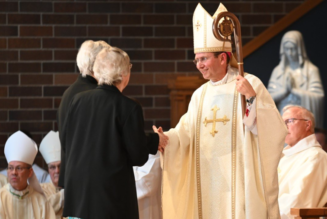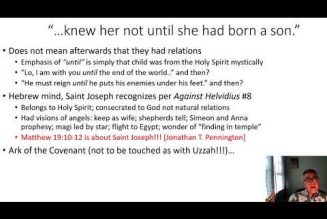Q: How is the date of Easter determined?
A: The answer to this question was hotly debated, but peacefully resolved, in the early centuries of the Church.
One opinion held that the resurrection of the Lord ought to take place according to the Hebrew calendar on 14 Nisan (roughly the end of March in today’s calendar). Nisan is the name of the month—which is measured by the lunar phases—during which Passover takes place. Nisan begins with the new moon (or on a moonless night during the lunar phase), reaches its midpoint at the full moon on the 14th day, and ends at the end of the moon’s waning. Those who held this view of when Easter ought to be dated, associated most commonly with St. Polycarp of Smyrna (martyred in 155), were called the “Quartodecimans,” or, roughly, the “Fourteeners.” A second opinion on the dating of Easter, headed by Pope Anicetus (d.168), thought that the celebration of Christ’s resurrection ought always to take place on a Sunday, the day on which our Lord rose. And since 14 Nisan can fall on any day of the week (much as December 25 does for us today), that particular day of the month ought to give way to the first day of the week in the Christian calendar—Sunday.
A formula that accounted for both lines of thought was settled at the Council of Nicaea in 325: the date of Easter will fall on the first Sunday (acknowledging Pope Anicetus’s thinking), after the first full moon (satisfying the Quartodecimans) of the spring equinox. To further complicate things, the actual equinox can move between March 20 and 22, but it is always dated as the 21st for the sake of computation. According to this formula, the earliest date of Easter is March 22, while the latest date of Easter is April 25. In 2024, the first full moon after the March 21 equinox is Monday, March 25, and the first Sunday following that is March 31.
This complex set of calculations may seem excessively meticulous, but for the Church all reality is sacramental—even time. These metrics for setting the calendric date of Easter reflect the Church’s perennial desire to express the Paschal mystery in sacramental terms.
Q: When does the veiling of crosses take place during Lent?
A: The first rubric in the Roman Missal appearing at the beginning of the Fifth Sunday of Lent reads, “In the Dioceses of the United States, the practice of covering crosses and images throughout the church from this Sunday may be observed. Crosses remain covered until the end of the Celebration of the Lord’s Passion on Good Friday, but images remain covered until the beginning of the Easter Vigil.” The former Sacramentary placed a similar rubric at the very end of the Mass for Saturday of the 4th week of Lent: “The practice of covering crosses and images in the church may be observed, if the episcopal conference decides.” Thus, the current Missal not only relocates the rubric from after Saturday of the 4th week to the beginning of Sunday of the 5th week, but it also states clearly that the U.S. Bishops have so decreed that the veiling may take place.
Why cover statues beginning on the 5th Sunday of Lent? Historically (and at present in the pre-conciliar liturgy), the 5th Sunday of Lent was called “Passion Sunday.” Its gospel reading from John (8:46-59) ends with Jesus telling some of the Jews, “‘I say to you, before Abraham came to be, I AM.’ So they picked up stones to throw at him; but Jesus hid and went out of the temple area” (58-59). Some associate Jesus’ “hiding” as the source of covering his and his saints’ images beginning on this day. But if for some reason it is not possible to cover the statues and crosses on this day, which is an option, then a rubric following Holy Thursday’s Mass of the Lord’s Supper directs that “if possible, the crosses are removed from the church,” adding, “It is expedient that any crosses which remain in the church be veiled” (n.41).
The Holy See’s 1998 letter “On the Preparation and Celebration of the Easter Feasts” (Paschalis Sollemnitatis) adds the further detail about the veils’ color: that “it is fitting that any crosses in the church be covered with a red or purple veil” (57).
Q: Is a cross or crucifix to be used for adoration on Good Friday?
A: The answer to this question in unclear, either from the documents, from history, or from recent practice.
A strong case can be made for using a cross without a corpus upon it. Originally, the veneration was literally of the true cross itself, or at least a relic of it. But since the cross’s relics could not be provided in every possible location, another cross was used in its place. The language in the Missal seems also to indicate a cross rather than a crucifix. This section of the Good Friday liturgy is called “The Adoration of the Holy Cross”; the text for the showing is “Behold the wood of the cross,” saying further that it is the cross “on which hung” (in the past tense: his body no longer hangs) the savior of the world. Elsewhere in the Missal, if a crucifix is desired, it is indicated as such with the phrase, “cross adorned with a figure of Christ crucified” (see GIRM 117, 122)—wording that does not appear in the Missal to describe the Good Friday cross. Furthermore, in the First Form for showing the cross, the Good Friday rubrics describe the uncovering of “the right arm of the cross,” rather than the right arm of Christ.
On the other hand, the more common practice of the tradition appears to be the adoration of a cross with the body of Christ upon it—a crucifix. The legislator himself appears to have this in mind, since images are easily accessible of Pope John Paul II, Pope Benedict XVI, and Pope Francis each adoring a crucifix on Good Friday.
Besides the instructions in the Roman Missal, the Holy See’s 1988 circular letter, Paschalis Sollemnitatis, says that “For veneration of the cross, let a cross be used that is of appropriate size and beauty, and let one or other of the forms for this rite be carried out with the splendor worthy of the mystery of our salvation” (68). So, whether cross of crucifix, a representation of the holy wood on which our Lord was put to death must be large, beautiful, and “one in number” (see Roman Missal, Good Friday, 19).
Some readers disagreed with our analysis. You can read some of those opinions here.
Q: When are the lights in the church building turned on at the Easter Vigil?
A: The Roman Missal says quite clearly that after the deacon or other minister reaches the sanctuary and has sung “The Light of Christ” for the third time, he “places the paschal candle on a large candlestand prepared next to the ambo or in the middle of the sanctuary. And lights are lit throughout the church, except for the altar candles” (17). In other words, the illumination of the church building doesn’t wait until after the singing of the Exsultet, nor after the readings, but precedes them both.
The Easter Vigil celebrates a new creation, a creation that is symbolized in large part by a new fiat lux, “Let there be light.” While the vigil begins in darkness, the darkness is soon swallowed up by light. The holy fire lights the Paschal Candle, and its coals ignite the incense within the thurible prior to the procession. This same new light is then passed from taper to taper among the people, gradually increasing the light in the church before the building’s usual light source completely transforms the church from darkness to light.
Reflecting this transformation, the poetic text of the Exsultet sings of the new light that now surrounds us. And the Old Testament figures—who until Christ’s coming were only shadows—take on clarity as they reveal our new creation on this new first day of the week.
Q: Which of the three options should we use to bless holy water at the Easter Vigil?
A: The instructions directing the blessing of holy water at the Easter Vigil are often difficult to decipher. The rubrics indicate three circumstances that will determine which blessing text ought to be used.
The first scenario, and the ideal one, envisions the sacrament of baptism, either of adults or of infants, taking place at the vigil. If this is the case, the rubrics indicate, “If there are candidates to be baptized,” the priest says: “Dearly beloved, with one heart and one soul, let us by our prayers come to the aid of these our brothers and sisters in their blessed hope, so that, as they approach the font of rebirth, the almighty Father may bestow on them all his merciful help” (Roman Missal, Easter Vigil, 40). The Litany of the Saints and the prayer of blessing follow.
A second circumstance finds no persons present for baptism, but a font that will be used for baptisms over the course of the next year. Here, the Missal states, “If the font is to be blessed, but no one is to be baptized,” the priest says, “Dearly beloved, let us humbly invoke upon this font the grace of God the almighty Father, that those who from it are born anew may be numbered among the children of adoption in Christ” (ibid.). As in the first option, the Litany of the Saints and the blessing of water follow (see Roman Missal, Easter Vigil, 41). It is not always apparent when this second circumstance exists. While it’s obvious when there are any persons for baptism, it is not always clear that the font needs to be blessed. After all, how many times does a font need to be blessed? In fact, the font is to be blessed each year—but the third option seems to confuse the issue.
According to the Roman Missal (42, 54), the third option for the blessing of the water is used “if no one is to be baptized and the font is not to be blessed.” This option is chosen if there is in fact no font at all, such as in a monastery, convent, seminary, shrine, or other chapel where baptisms would not usually take place. In this instance, there is no font to be blessed and the Litany of the Saints is not sung; only a vessel of holy water is blessed. Parish churches, which always require a baptismal font, are obviously not in this category.
Q: What resources can help pastors and the faithful prepare for and celebrate Holy Week?
A: Primary sources include the Church’s own ritual books and documents: the Roman Missal, the Lectionary for Mass, the Liturgy of the Hours, and the 1988 circular letter “On the Preparation and Celebration of the Easter Feasts” (Paschalis Sollemnitatis).
Secondary sources include Jesus of Nazareth: Holy Week, by Pope Benedict XVI (Ignatius Press, 2011), Glory in the Cross: Holy Week in the 3rd Edition of the Roman Missal, by Father Paul Turner (Pueblo, 2011), and A Devotional Journey into the Easter Mystery, by Christopher Carstens (Sophia, 2019).
—All question answered by the Editors
Image Source: AB/Jes on Flickr









